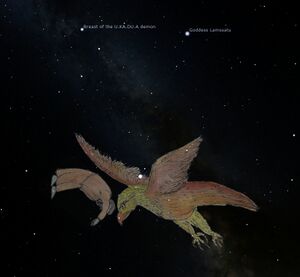KA
mulKA (𒀯𒅗) = pû is an ancient Mesopotamian asterism that is equaled to the constellation of The Dead Man (AD6, pagru), and can be used more generally to refer to mouth-shape asterisms in larger astral figures, for example mulKA.MUŠ.I3.GU7.E (Kurtik k05) and the mouths of two asterisms in the Dalbanna-text (see below).
The Sumerian KA is used in the gloss mu-ulka-a for mulKA5.A = šēlebu, “Fox” in SAA 8[1] 49: 9.
Concordance, Etymology, History
Krebernik (2023)
= šēlebu, “fox”. mulKA5.A (EN 17r).
Kurtik with Hilder, Hoffmann, Horowitz, Kim
= pû "Mouth"; Var. designations:
- 1) constellation or star in Delphinus (?) [Gössmann[2] 204; Reynolds 1999[3]], in the specific case when it refers to the area of the Dead Man.
- 2) figure the element of some constellations.
| Sources | Identifications |
|---|---|
| "Great Star List" | |
Calendrical ritual text BM 55466+.
|
|
| Dalbanna-text. |
See also (Kurtik a09) AD6, (Kurtik g24) Gizzānītu.
Additional
II. Identification.
As a constellation:
Since the Mouth is identified with the Deadman, we can consider these names as representing the same constellation/star in the constellation Delphinus(?) [Weidner 1959-60[10], 108, Anm. 22].
As an element of the figure of the constellation:
(1) UR.GI7, V 1 (Kurtik u19).
(2) LU.LIM, V 7 (Kurtik L09).
Historical Dictionaries
| Kurtik (2022, k01) | Gössmann (1950) |
|---|---|
| = pû «Рот»; 1) созвездие или звезда в Дельфине (Delphinus) (?) [G. 204; Reynolds 1999], 2) элемент фигуры некоторых созвездий.
I. Источники. «Большой список звезд». mulka = mullu2.uš2 «Рот = Мертвец» [Mesop.Astrol., App. B:160; Weidner 1959–60, 107:22 u. Anm., Taf. XXXI iii 22]. Календарный ритуальный текст BM 55466+. a) pu-uš-ša2-ni-tu4 pu-u2 za-ni-tu4 šum3-šu2 ana muḫ-ḫi múlpî(ka) qa-bi «Пушшаниту его имя, что означает Сердитый Рот, так говорят, (когда имеют в виду) созвездие (звезду) Рот»; b) múlpû(ka) : múlpagru(adda) : ti-amat tu-u16-am-tu4 šum3-šu2 2 pa-nu-šu2 ziqar(nita) u sinniš(munus) šu-u2 «(Созвездие/звезда) Рот эквивалентно (созвездию) Мертвец, которое эквивалентно Тиамат. Его имя — женские близнецы, у него два лица – мужское и женское» [STC II, Pl. LXX r. 12; Reynolds 1999, 370–371, 376]. Dalbanna-текст. §K. [mu]l ka x x x [Walker 1995, 31; ASM, 106]; = [mu]lka l[u?.li]m? «рот Оленя» (ε Cas), согласно [Koch 1995, 58]. §z. mulka ur.gi7 «Пасть Пса (φ Her) [Walker 1995, 41; Koch 1995, 51, 64; ASM, 111]. См. также a09AD6, g24Gizzānītu. II. Отождествление. Как созвездие: Поскольку Рот отождествляется с Мертвецом, можно думать, что речь идет о названиях одного и того же созвездия/звезды в созвездии Дельфина(?) [Weidner 1959–60, 108, Anm. 22]. Как элемент фигуры созвездия: (1) UR.GI7, V 1 (u19). (2) LU.LIM, V 7 (L09). |
Example |
References
- ↑ Hunger H. Astrological Reports to Assyrian Kings. Helsinki, 1992 (State Archives of Assyria, VIII).
- ↑ Gössmann P.F. Planetarium Babylonicum, Rom, 1950 (A. Deimel. Šumerisches Lexikon 4/2).
- ↑ Reynolds F. Stellar Representations of Tiāmat and Qingu in a Learned Calendar Text // RAI. 1999. Vol. 42. P. 369-378.
- ↑ Koch-Westenholz U. Mesopotamian Astrology. Copenhagen, Museum Tusculanum Press. 1995.
- ↑ Weidner E. Ein astrologischer Sammeltext aus der Sargonidenzeit // AfO. 1959-1960. Bd. 19. S. 105-113.
- ↑ King L.W. The Seven Tablets of Creation. Vol. I-II. London, 1902.
- ↑ Reynolds F. Stellar Representations of Tiāmat and Qingu in a Learned Calendar Text // RAI. 1999. Vol. 42. P. 369-378.
- ↑ 8.0 8.1 Hunger H., Pingree D. Astral Sciences in Mesopotamia. Leiden-Boston-Köln, 1999.
- ↑ 9.0 9.1 Koch J. Der Dalbanna-Sternenkatalog // WO. 1995. Bd. 26. S. 43-85.
- ↑ Weidner E. Ein astrologischer Sammeltext aus der Sargonidenzeit // AfO. 1959-1960. Bd. 19. S. 105-113.





